CSS魔法堂:重拾Border之——不仅仅是圆角
前言
当CSS3推出border-radius属性时我们是那么欣喜若狂啊,一想到终于不用再添加额外元素来模拟圆角了,但发现border-radius还分水平半径和垂直半径,然后又发现border-top-left/right-radius的水平半径之和大于元素宽度时,实际值会按比例分配元素宽度时,不禁会问"我真的懂border吗?"。本系列将稍微深入探讨一下那个貌似没什么好玩的border!
《CSS魔法堂:重拾Border之——解构Border》
《CSS魔法堂:重拾Border之——图片作边框》
《CSS魔法堂:重拾Border之——不仅仅是圆角》
《CSS魔法堂:重拾Border之——更广阔的遐想》
圆角进化论
当设计稿上出现圆角按钮/标签页时,我们会如何应对呢?CSS3到来之前最广为人知的应该就是"滑动门"(sliding door)实现方式了。
滑动门实现法

<style type="text/css">
ul{padding:0;margin:0;}
li{padding:0;margin:0;list-style:none;}
a{margin:0;text-decoration:none;}
/*clearfix*/
.nav{
*zoom: 1;
}
.nav::after{
content: ".";
display: block;
clear: both;
line-height: 0;
visibility: hidden;
}
/*滑动门实现Tab*/
.nav .nav-item{
float: left;
margin-right: 5px;
}
.nav .nav-item a{
display: inline-block;
background: url("./background.jpg") no-repeat;
color:#333;
font-size: 12px;
line-height: 2;
}
.nav .nav-item a span{
display: inline-block;
background: url("./background.jpg") no-repeat right top;
padding: 0 10px 0 5px;
margin-left: 5px;
}
.nav .nav-item a:hover{
background: url("./background.jpg") no-repeat left -30px;
}
.nav .nav-item a:hover span{
background: url("./background.jpg") no-repeat right -30px;
}
</style>
<ul class="nav">
<li class="nav-item"><a href="javascript:void 0"><span>首页</span></a></li>
<li class="nav-item"><a href="javascript:void 0"><span>PDCA检验单查询</span></a></li>
<li class="nav-item"><a href="javascript:void 0"><span>成品通用标准审核</span></a></li>
</ul>
border-radius实现法
border-top-left-radius: [<length>|<percentage>]{1,2}
border-top-right-radius: [<length>|<percentage>]{1,2}
border-bottom-left-radius: [<length>|<percentage>]{1,2}
border-bottom-right-radius: [<length>|<percentage>]{1,2}
设置左上/右上/左下/右下角水平和垂直椭圆半径
<length>:以带单位的绝对值作为半径;
<percentage>:以对应border box的尺寸(不是border-width)为参考系,设置半径;
注意:结果值为0(默认值)时,为直角边框
border-radius: [<length>|<percentage>]{1,4} [/[<length>|<percentage>]{1,4}]?:一次过设置4个角的椭圆半径
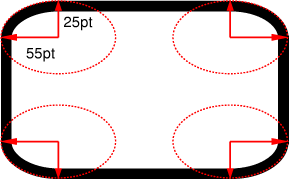
从上图我们可以看到4个角分别对应4个独立的椭圆形,而圆角正是4分之1个椭圆。
撸代码!

<style type="text/css">
/*clearfix*/
.nav3{
*zoom: 1;
}
.nav3::after{
content: ".";
display: block;
clear: both;
line-height: 0;
visibility: hidden;
}
/*border-radius实现Tab*/
.nav3 .nav-item3{
float: left;
margin-right: 5px;
}
.nav3 .nav-item3 a{
font-size: 12px;
line-height: 2;
display: inline-block;
background: #0ac;
padding: 0 10px;
border: 1px solid #eee;
border-radius: 8px 8px 0 0;
}
.nav3 .nav-item3 a:hover{
background: #eef;
}
</style>
<ul class="nav3">
<li class="nav-item3"><a href="javascript:void 0">首页</a></li>
<li class="nav-item3"><a href="javascript:void 0">PDCA检验单查询</a></li>
<li class="nav-item3"><a href="javascript:void 0">成品通用标准审核</a></li>
</ul>
圆角的何止是border box啊

上图的content box变成椭圆形了,而且content box中的文字好像飘到content box外面。但确实是content box变为椭圆形还是说仅仅是背景色是如此而已呢?让我们添加overflow:hidden看看效果吧

看来border-radius确实影响到content box了。其实border-radius将会影响到box model中的所有box。当我们通过border-radius设置border box的椭圆半径后,CSS渲染引擎会根据公式自动计算出margin/padding/content box的椭圆半径,然后为它们渲染出圆角。
注意
- margin/border/padding/content box中相同方向的角的椭圆的圆心重叠;
- 当椭圆半径为0时,渲染为直角。
margin box圆角了
公式:margin-radius = border-radius + margin-width
当border-radius > margin-width时,margin-width=1 + (margin-width/border-radius-1)^3以确保margin-radius趋向于直角。
padding box圆角了
公式:padding-radius = border-radius + border-width
当padding-radius为0时,渲染为直角
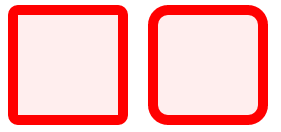
<style type="text/css">
.s1{
background: #FEE;
width: 0;
padding: 50px;
border: 10px solid red;
border-radius: 10px;
float:left;
margin-right: 20px;
}
.s2{
background: #FEE;
width: 0;
padding: 50px;
border: 10px solid red;
border-radius: 20px;
float:left;
}
</style>
<div class="s1"></div>
<div class="s2"></div>
content box/area圆角了
公式:content-radius = border-radius + border-width - padding-width
当content-radius为0时,渲染为直角

<style type="text/css">
.s1{
background: #FEE;
width: 100px;
height: 100px;
border: 10px solid red;
border-radius: 10px;
float:left;
margin-right: 20px;
}
.s2{
background: #FEE;
width: 100px;
height: 100px;
border: 10px solid red;
border-radius: 20px;
float:left;
}
</style>
<div class="s1"></div>
<div class="s2"></div>
注意
由于margin区域无法触发点击等事件,而圆角border box所占面积必定小于直角border box,因此为保持可点击区域面积,圆角border box应设置更大的高宽值。
话说"大值特性"和"等比特性"
@张鑫旭老师在《秋月何时了,CSS3 border-radius知多少?》提到"大值特性"和"等比特性"两个特性。
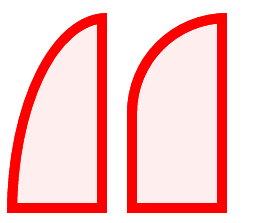
<style type="text/css">
.s1{
box-sizing: border-box;
background: #FEE;
width: 100px;
height: 200px;
border: 10px solid red;
border-top-left-radius: 100px 200px;
float: left;
margin-right: 20px;
}
.s2{
box-sizing: border-box;
background: #FEE;
width: 100px;
height: 200px;
border: 10px solid red;
border-top-left-radius: 200px;
float: left;
}
</style>
<div class="s1"></div>
<div class="s2"></div>
你看div.s2明明把左上角的水平和垂直半径设置为200px,但实际效果却是两者结果值均为100px,难道这就是"大值特性"?
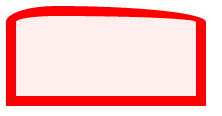
<style type="text/css">
.s1{
box-sizing: border-box;
background: #FEE;
width: 200px;
height: 100px;
border: 10px solid red;
border-top-left-radius: 300px 100px;
border-top-right-radius: 900px 100px;
}
</style>
<div class="s1"></div>
仅仅看div.s1水平方向的椭圆半径,left和right相加300+900=1200远远大于border box的宽度200px,也就是说两个椭圆将发生重叠。对于这种情况CSS渲染引擎到底是如何处理的呢?
- 首先明确的是
left+right必须小于等于border-box的宽度,也就是说两个椭圆不能发生重叠。 - 然后根据"等比例特性"得到
left/(left+right)=300/(300+900)=1/4,right/(left+right)=900/(300+900)=3/4,得到left结果值为200/4=50,right结果值为3*200/4=150。
通过"等比例特性"我们很好地解释了上图中水平方向的效果,但大家有没有发现垂直方向的半径有点奇怪呢?我们明明设置半径为100px,而且border box的高度恰好也是100px,按理应该是足够的,为何垂直半径的结果值不是100px呢?
其实W3C Spec中已经说得很清楚了!
Let f = min(Li/Si), where i ∈ {top, right, bottom, left}, Si is the sum of the two corresponding radii of the corners on side i, and Ltop = Lbottom = the width of the box, and Lleft = Lright = the height of the box. If f < 1, then all corner radii are reduced by multiplying them by f.
其实"最大值特性"和"等比例特性"只是上述规则的表象而已,最根本的公式为f=min(Li/Si)
以第二个示例来计算一下吧
计算f的值
- top-left和top-right的水平半径之和为1200px,而border box宽度为200px,那么f1=200/1200=1/6;
- top-left和bottom-left的垂直半径之和为400px,而border box高度为400px,那么f2=400/400=1;
- bottom-left和bottom-right的水平半径为0,忽略;
- top-right和bottom-right的垂直半径之和为400px,而border box高度为400px,那么f3=400/400=1;
- f=min(f1,f2,f3),结果为f=f1
缩放各半径
- top-left和top-right的水平半径分别乘以f,得到结果值
300/6=50,900/6=150; - top-left和top-right的垂直半径分别乘以f,得到结果值
400/6=66.66。
被忽视的猪脚——相交线
当设置border-left和border-top后,我们很容易预测到左边框和上边框的样式,但它俩相交部分的样式呢?这里就涉及到相交线的问题了!
通过直角边框找相交线
圆角边框是基于直角边框的,这一点也体现在相邻边框的相交线上。
<style type="text/css">
.box{
width: 100px;
height: 200px;
border: 50px solid;
border-left-color: red;
border-top-color: blue;
border-right-color: green;
border-bottom-color: yellow;
}
</style>
<div class="box"></div>
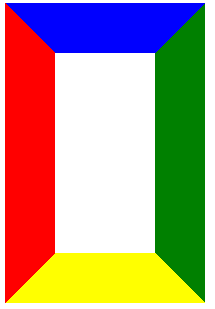
我们可以看到两边相交所形成的矩形的对角线,将作为边的相交点。通过相交点判断边框样式应应用到哪一条边上。
透视图如下

延长相交线
由于圆角边框不像直角边框那样有棱有角,因此更难以分辨边框样式所对应的边框。但只要我们沿直角边框的相交线向图形内延伸,一切则清晰明了了。
<style type="text/css">
.rounded-box{
width: 100px;
height: 200px;
border: 50px solid;
border-left-color: red;
border-top-color: blue;
border-right-color: green;
border-bottom-color: yellow;
border-radius: 100px;
}
</style>
<div class="rounded-box"></div>

透视图如下
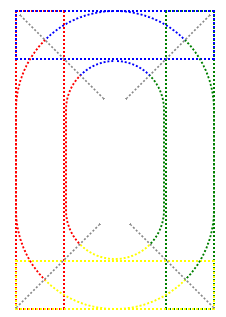
兼容性

虽然各大浏览器均支持border-radius属性,但其实现效果却不尽相同,我们拿极端情况来作试验,最能看出效果。结论是让我们大跌眼镜的:IE效果最为理想!!
<style type="text/css">
.s1{
box-sizing: border-box;
width: 200px;
height: 200px;
border: 50px solid;
border-color: red blue green yellow;
border-top-left-radius: 50% 100%;
border-top-right-radius: 50% 100%;
}
</style>
<div class="s1"></div>
chrome34中
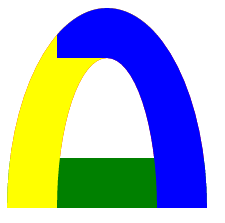
FF中
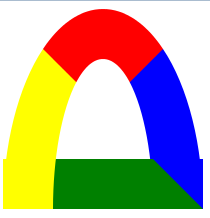
IE9
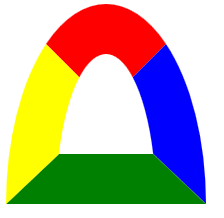
总结
尊重原创,转载请注明来自:http://www.cnblogs.com/fsjohnhuang/p/5458573.htm_肥仔John
感谢
CSS Backgrounds and Borders Module Level 3 4. Borders
秋月何时了,CSS3 border-radius知多少?
CSS滑动门Sliding door详解
《图解CSS3核心技术与案例实战》——第3章 CSS3边框
欢迎添加我的公众号一起深入探讨技术手艺人的那些事!
如果您觉得本文的内容有趣就扫一下吧!捐赠互勉!




